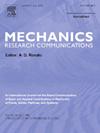A discrete model for elasticity with microstructure
IF 2.3
4区 工程技术
Q3 MECHANICS
引用次数: 0
Abstract
In the mid-1960s, Mindlin introduced his theory of strain gradient elasticity (SGE), along with one of its most widely recognized simplified versions, known as SGE-Form II. These enhanced theories were motivated by the need to capture dynamic phenomena that classical elasticity fails to address. Although theoretically elegant, the inclusion of numerous material constants and internal length scale parameters makes the practical application of both SGE and SGE-Form II challenging—even for one-dimensional (1D) problems. A practical approach for identifying these parameters involves validating the theories through lattice models, where both the microstructure and macrostructure are materially and geometrically well-defined. Using a simple 1D lattice model with nearest and next-nearest neighbor spring connections and distributed mass, Polyzos and Fotiadis (Int. J. Solids Struct. 49, 470–480, 2012) were the first to successfully validate Mindlin’s SGE-Form II and to interpret the intrinsic parameters introduced by the theory. Despite significant efforts, no lattice model has yet been shown to fully replicate the behavior described by the general SGE theory, even in 1D cases. This gap is addressed in the present work through the use of a simple 1D lattice model and the implementation of a continualization process similar to that employed by Polyzos and Fotiadis (2012).
具有微观结构的离散弹性模型
在20世纪60年代中期,Mindlin介绍了他的应变梯度弹性理论(SGE),以及其最广泛认可的简化版本之一,即SGE- form II。这些强化理论的动机是需要捕捉经典弹性力学无法解决的动态现象。虽然理论上很优雅,但包含大量材料常数和内部长度尺度参数使得SGE和SGE- form II的实际应用具有挑战性-即使是一维(1D)问题。确定这些参数的实用方法包括通过晶格模型验证理论,其中微观结构和宏观结构在材料和几何上都是明确定义的。利用具有最近邻和次近邻弹簧连接和分布质量的简单一维晶格模型,Polyzos和Fotiadis (Int.;J. Solids Struct. 49, 470-480, 2012)首次成功验证了Mindlin的SGE-Form II,并解释了该理论引入的内在参数。尽管付出了巨大的努力,但目前还没有晶格模型能够完全复制一般SGE理论所描述的行为,即使在一维情况下也是如此。在目前的工作中,通过使用简单的一维晶格模型和实现类似于Polyzos和Fotiadis(2012)所采用的连续化过程来解决这一差距。
本文章由计算机程序翻译,如有差异,请以英文原文为准。
求助全文
约1分钟内获得全文
求助全文
来源期刊
CiteScore
4.10
自引率
4.20%
发文量
114
审稿时长
9 months
期刊介绍:
Mechanics Research Communications publishes, as rapidly as possible, peer-reviewed manuscripts of high standards but restricted length. It aims to provide:
• a fast means of communication
• an exchange of ideas among workers in mechanics
• an effective method of bringing new results quickly to the public
• an informal vehicle for the discussion
• of ideas that may still be in the formative stages
The field of Mechanics will be understood to encompass the behavior of continua, fluids, solids, particles and their mixtures. Submissions must contain a strong, novel contribution to the field of mechanics, and ideally should be focused on current issues in the field involving theoretical, experimental and/or applied research, preferably within the broad expertise encompassed by the Board of Associate Editors. Deviations from these areas should be discussed in advance with the Editor-in-Chief.

 求助内容:
求助内容: 应助结果提醒方式:
应助结果提醒方式:


